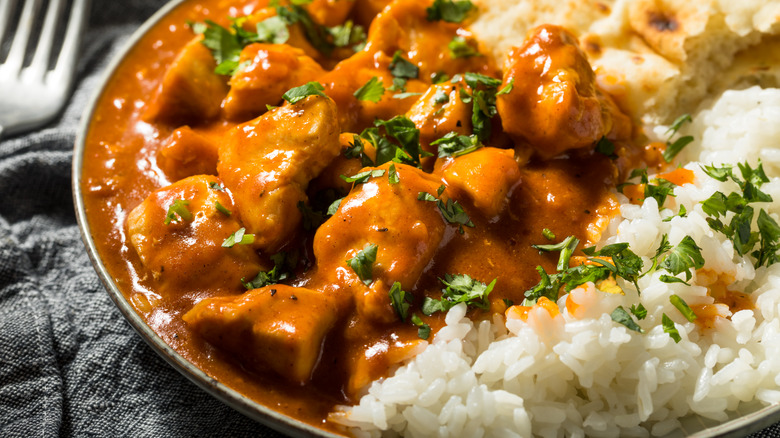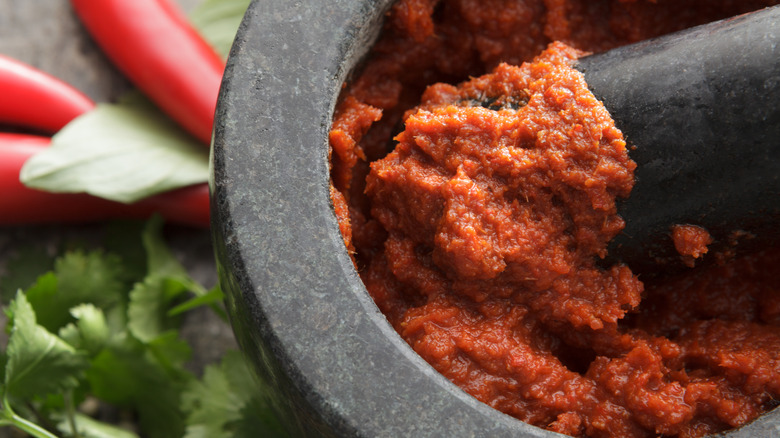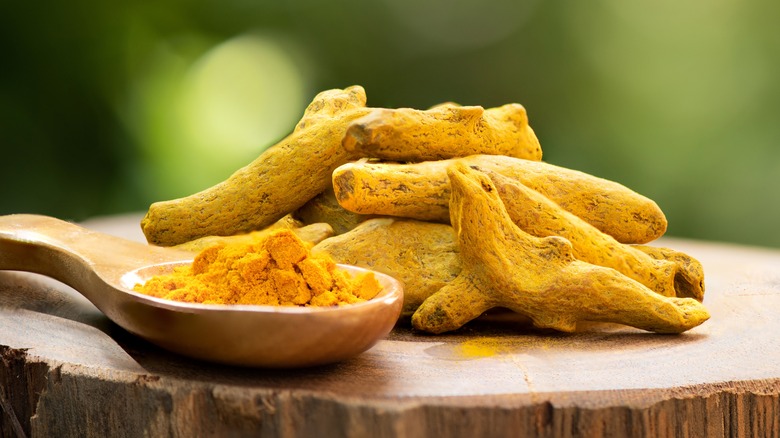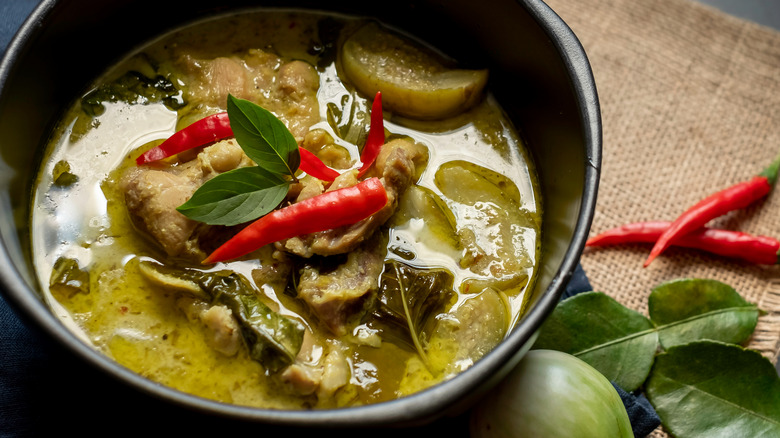How To Choose The Best Chili Paste For Your Curry Chicken
The quest for the perfect chicken curry recipe can make you feel a little like Goldilocks, tasting each one until you find one that's just right. While it's a pleasant search, the journey can be made easier if you know more about how different curries are flavored and what they're best paired with.
A saucy and aromatic South Asian dish containing coconut milk, vegetables, and (sometimes) meat, curry is a staple in Indian and Thai cuisine. While Thai curries are generally made with curry paste, a puree of fresh herbs and spices, Indian curries are often crafted with a combination of dried spices. Several curries are made in both regions, but most people recognize three distinct categories: red, yellow, and green.
Not only do the three have different spice levels, but they also have different flavoring agents that create distinctive colors and tastes. Knowing what goes into each can help you decide which kind of curry paste is best for your next batch.
Red curry paste is a versatile choice
Touted as the "every-curry paste," red curry is the most versatile and accessible. While its fiery red color might lead you to believe it's the hottest of the bunch, it is much milder than its green cousin. Once containing upwards of 20 different types of chili peppers, these days, red curry paste's bright red hue is attributed to chili powder and tomato paste.
Aside from red chilis, red curry paste is typically flavored with coriander, shrimp paste, lemongrass, garlic, shallots, and galangal. This combination creates a mildly spicy sauce that pairs well with poultry, beef, pork, shrimp, and heartier fish such as salmon. Red curry paste is also the basis for Panang curry, a sweet, intensely spicy coconut curry from Malaysia. Red curry paste can also be mixed with mayonnaise and spread on Thai-inspired chicken sandwiches or stirred into soups for a well-seasoned broth.
Yellow curry paste adds a mellow sweetness
Regarding spice level and flavor, yellow curry paste is the most mellow. Much like other Thai curry pastes, it takes on the color of the chilis used to flavor it. As such, yellow curry paste gets some of its golden hue from yellow chili peppers. However, most of the color comes from turmeric and ingredients like coriander seeds, cumin, lemongrass, galangal, ginger, and garlic.
Yellow Thai curry paste tastes similar to Indian curry, traditionally crafted with dry spices such as turmeric, cumin, coriander, ginger, fenugreek, and chili peppers. However, the ginger and lemongrass found in yellow curry paste work to brighten the intensely warming flavors, making it a suitable match for lighter fare like poultry, seafood, vegetables, or lentils. The sweeter nature of yellow curry also makes it more of an accessible family meal, whereas green curry and red curry might be too spicy for little ones.
Green curry paste brings the heat
Originating from Thailand, green curry paste is the spiciest of the curries. (For reference, many Thai eateries ask tourists if they want their meal prepared "spicy" or "Thai spicy," as the word takes on a different meaning for locals.) While typical green Thai chilies are generally considered mild compared to their red counterparts, the uptick in green curry paste's spiciness can be attributed to the addition of Bird's Eye chilis. Measuring 90,000 on the Scoville scale, the "Guinness Book of World Records" once declared them the hottest peppers in the world.
Spiciness aside, green peppers add to the curry paste's vibrant color, along with fresh coriander, lemongrass, Kaffir lime leaves, and sweet basil. Despite all of these bright and citrusy flavors, the overwhelming quality of green curry is "hot," whereas red curry and yellow curry have more depth of flavor. Luckily, coconut milk works to make the spicy chilis more palatable. If you're in the mood to get your sweat on, green curry paste works well with chicken, shrimp, and fish, or if you're going the vegetarian route, try vegetables or chickpeas.



